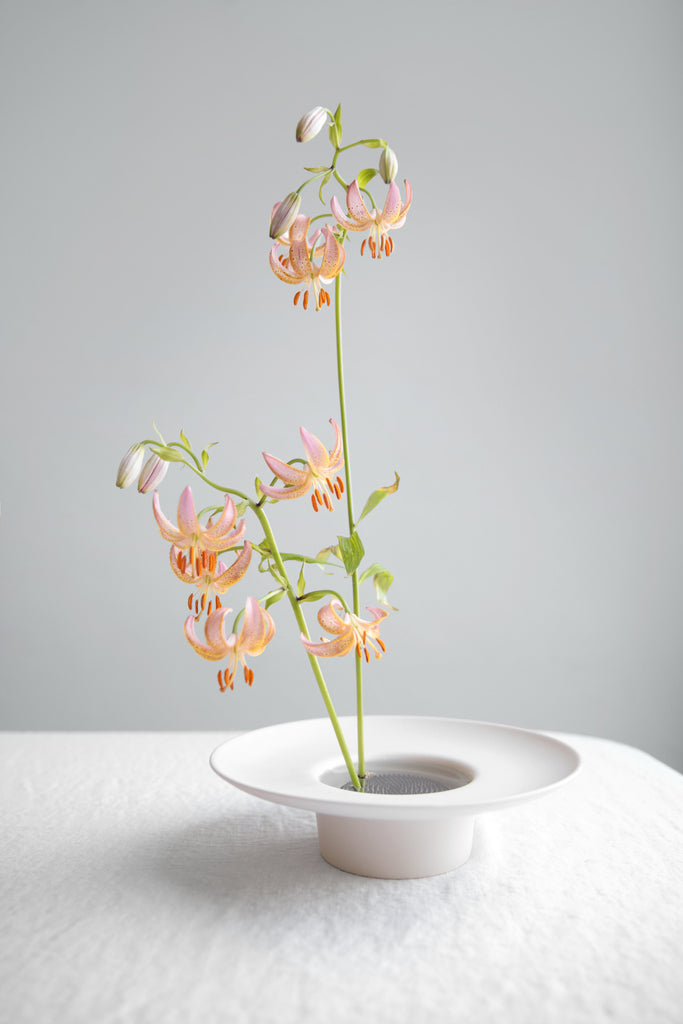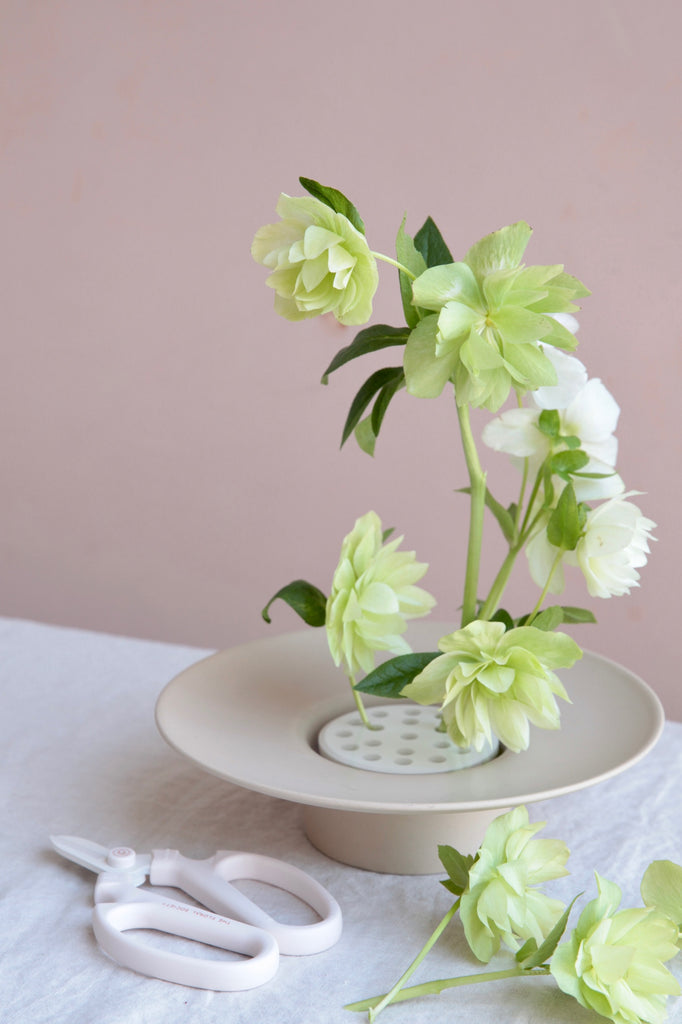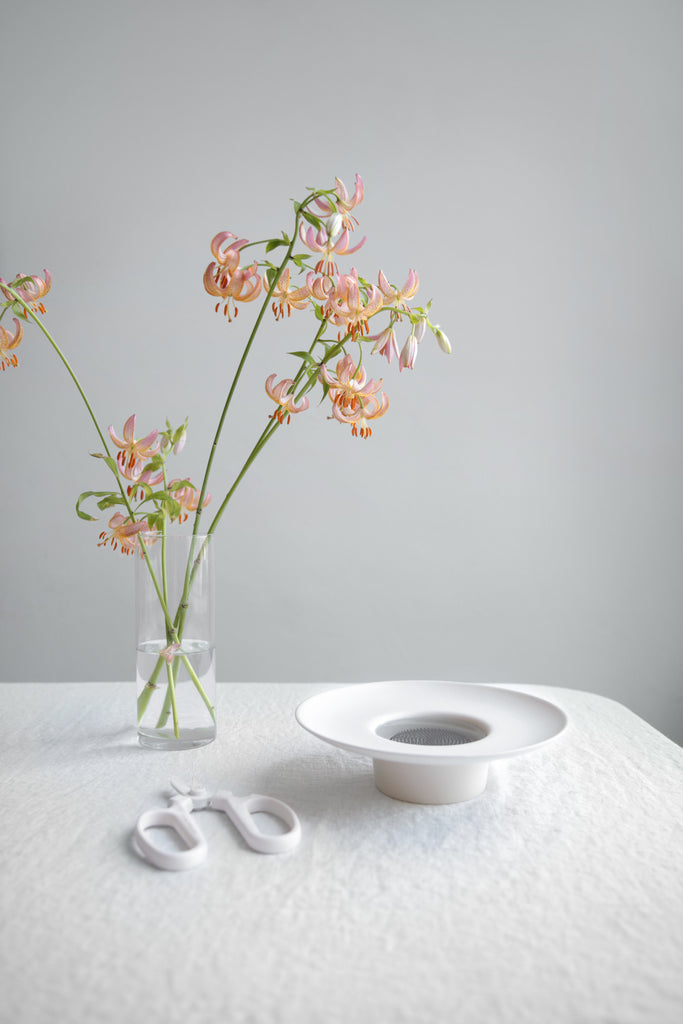I was introduced to the art of Ikebana floral design about 15 years ago when I started working with flowers and it changed the way I think about flowers and approach floral arranging. The thought, tradition and design principles that are infused into ikebana arrangements makes it an informative style of arranging no matter what style of floral design you are practicing. Studio Mondine’s book Ikebana Unbound has become an essential tool to learning about the modern approach to this ancient Japanese art of flower arranging and is highly recommended to learn more about how this art form can be applied to modern day floral arranging.
Part art, part meditation, ikebana flower arrangements use seasonal flowers, branches, produce, moss and leaves to create sculptural arrangements filled with symbolism. In this ikebana guide, we will explore the art of Ikebana, its origins, techniques, and modern-day practice of this ancient art form.
What is Ikebana?

Ikebana is the traditional Japanese art of floral design that combines Japanese culture and symbolism to highlight the perfect imperfection of nature and human emotion in floral design. The origins of ikebana date back to the sixth century, when Buddhism was introduced to Japan from China and Korea. Floral offerings to Buddha known as "kuge" were left on temple altars.
Ikebana uses lines, color, movement, space, shape and balance as its main points of focus. The word "Ikebana" comes from the Japanese words Ikeru (to arrange, be living, or have life) and Hana (flower). Unlike other floral arranging techniques, which are largely informal, ikebana’s are precise and meaningful.
Ikebana focuses on seven harmonious principles intended to make the practice a peaceful, mindful style of arranging flowers. Ikebana is considered a form of meditation so silence can help the mind focus on the arrangement in front of you. Minimalism is at the heart of ikebana setting it apart from fuller western style of arranging. The form of ikebana allows flowers to stand naturally and flow with nature. Those who practice ikebana believe that your emotions guide your design, as opposed to logic. Seasonality is a core part of ikebana and lastly, creating a triangular shape with flowers, symbolic of Ten (heaven), Chi (earth) and Jin (man) is essential to ikebana arrangements.
Embracing Minimalism
At the core of Ikebana is the concept of minimalism and simplicity. Unlike conventional arrangements, Ikebana floral arrangements focus on the beauty of individual flowers, leaves, and branches, while also viewing negative space as an essential element. The arrangement is thoughtfully composed, incorporating various elements to create a harmonious outcome.
Ikebana floral design is considered a true art form using movement, lines, color, space, shape and balance to create a floral sculpture that is visually pleasing. Some ikebana arrangements may consist of a single flower and bare branches, others can be made with many elements, including flowers and branches and other natural elements such as stones, moss and fruit.
The Three Fundamental Elements
Traditional ikebana arrangements consist of three fundamental elements known as the Shin, Soe, and Hikae. The Shin represents the tallest and most prominent part, symbolizing heaven or the spiritual realm. The Soe serves as a secondary element, representing humanity and connecting the Shin and Hikae. The Hikae is the lowest and smallest element, symbolizing the earth or the physical realm. These elements work together to create a feeling of balance and harmony.
Ikebana emphasizes the use of lines, shapes, and forms to convey meaning and express the artist's intentions. Lines can be vertical, horizontal, or diagonal, creating a sense of movement and energy. Shapes can be angular or curved, representing natural elements or symbolic meanings. Forms can be open and spacious or compact and intricate, depending on the desired aesthetic. Ikebana vases will help guide both the expert and rookie ikebana practitioner.
Seasonal Inspiration

Ikebana is deeply connected to the changing seasons and celebrates the beauty of nature throughout the year. Each season offers unique materials and colors that inspire Ikebana arrangements. In the spring Cherry Blossoms are often a focus, sunflowers in summer, chrysanthemums in autumn, and pine branches in winter are just a few examples of the seasonal elements often incorporated into Ikebana.
Styles of Ikebana
Over time, more than a thousand schools of ikebana have emerged and in modern day ikebana is being practiced by people around the world with a more casual approach. There is often less a focus on the specifics of each style and more emphasis is being placed on the shapes, lines, colors and materials that are often found in ikebana arrangements. We’ve highlighted four of the most well-known styles of ikebana below.
Sogetsu Ikebana
One of the most popular schools of ikebana is Sogetsu, which focuses on the creative freedom and encourages you to explore unconventional materials and forms. Sogetsu ikebana supports the idea that anyone can create an arrangement that reflects their own personal style. It encourages the practitioner to experiment while respecting the fundamental principles of balance and harmony that define ikebana. Professional ikebanists study for years to become masters in ikebana, however all are encouraged to begin practicing ikebana at any level and create ikebana-inspired designs without any training.
Nageire Ikebana
Nageire, which means “to throw in”, is known as a freestyle approach to ikebana with a goal to highlight flowers natural forms and is typically practiced in a tall vase.
Jiyu-bana Ikebana
This is the freest style of ikebana and arose in the 1920’s. It is often interpreted as a “you do you” style, highlighting the designer’s feelings about the elements in the arrangement more than the flowers themselves. At the core of this style of ikebana is still about appreciating nature and highlighting seasonal elements. It still prioritizes negative space and asymmetry.
Rikka Ikebana
Rikka is known to date back to late fifteenth century, it’s the earliest style of ikebana. It intends to create a natural landscape in its entirety with a complex arrangement, typically consisting of nine branches arranged in very specific positions.
Vases & Tools for Ikebana Arrangements

Ikebana Vases
Ikebana floral vases should be aesthetically pleasing, balanced within the design and should leave the surface of the water visible. This is to fulfill one of the principles of ikebana which is to imitate plants growing in nature. Some styles of ikebana recommend a low dish or vase, others recommend tall, cylindrical vases or oblong boat-shaped vases. If you’re a beginner, grab any low, dish you may have in your cabinet to get started. Whichever style of vase you choose, make sure to wash it with dish soap and rinse it clean with water before you begin arranging. See our Ikebana ceramic vase options here.
Tools for Ikebana Arrangements
Like any style of floral arranging there are a handful of tools that you’ll want to stock your kit with before you get started. We’ve outlined the tools that we find most helpful when starting an ikebana practice.
Pin frogs: We’ve highlighted the style of vase that is best for ikebana arrangements, but there are some other tools you’ll want to consider using as well. Japanese pin frogs (kenzens) are the most useful tool to use when designing ikebana arrangements. Their spikes hold stems in place and help them to stay hydrated. When using a pin frog, cut the base of the flower stem at an angle to make it easier to insert and stabilize the element. When using thicker branches in your designs, cut a portion away to make the bottom of the branch thinner. Use force to push the branch into the pin frog needles.
Other support structures: Vines and thin branches can create support structures in your vase for stems to be held in place. Keep in mind that these materials will be submerged in water so you’ll want to choose material that will not lose its integrity when wet.
Floral netting is a great option to consider when working with unusually shaped vessels. It can be shaped to mimic the shape of any vessel. This can also be used in addition to a pin frog for additional support.
Floral clippers: If you become a regular practitioner of ikebana you may want to consider a few different types of cutting tools for the various elements. Japanese floral clippers are best for cutting most flower stems whether you’re snipping a delicate bloom such as sweet pea or a heartier stem such as a mum. These are considered your essential tool.
Pruners: Japanese pruners are great for thick stems and branches. They’re capable of cutting through tougher elements you may use in your ikebana arrangement.
Floral stem tape: Floral stem tape is a useful tool if you have delicate blooms such as bluebells that are too thin to be inserted into a pin frog. Gently wrap a few stems together with your stem tape and insert the bundle into your ikebana arrangement.
Pro Tip: Cut your stems under running water to prevent your stem from coming in contact with air. This will maximize the amount of water the stem will absorb. A diagonal cut is best when trimming stems.
For additional resources, tools and to learn more about Ikebana and other styles of floral arranging explore The Floral Dispatch.
Modern Ikebana Arrangement 101
We’re going to concentrate on the Nageire style of ikebana arranging to begin, which will allow us to celebrate our own individual approach and focus on our personal feelings to each of the floral elements we’re working with. We’ll follow the traditional approach of a Shin, Soe and Hikae element in our arrangement to achieve balance and a visually pleasing ikebana arrangement.
Take your time placing the elements in your vase and remember to leave negative space in your ikebana arrangement. If you’re attempting to create a traditional ikebana arrangement the Shin should be placed at a straight angle and tilted about 15 degrees to the left, with the Soe angled about 45 degrees to the left, and the Hikae at the front angled about 75 degrees to the right for balance. Before you’ve finished your ikebana arrangement you can add in other natural elements to your liking such as smaller flowers or moss, but it should be done sparingly to maintain the minimalist style.
Ikebana is a unique art form that offers a different perspective on floral arrangements. By exploring this ancient, meditative practice it brings us closer to not only nature, but to ourselves and our most important creative attributes. The skills we learn from Ikebana can be applied to other styles of floral arranging to enhance our abilities to transform a space, a life and our homes with nature’s bounty.
